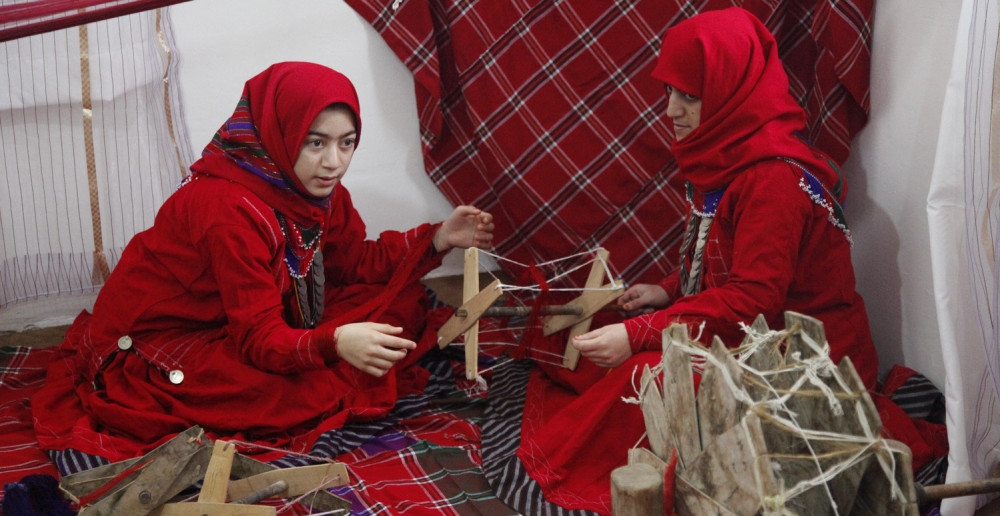
Golestan Silk Weaving
Golestan silk weaving is one of the most prosperous and important industries in this province, which has a long history. Historical reports indicate that this region and the city of Gorgan was one of the main centers of silk production during the Safavid period. Different regions of the province, including Ramyan, Minoodasht and Turkmen Sahara, are prominent in silk production today. Silk weaving is a process that begins with the cultivation of silkworms and ends with the weaving of products. Yarn production and dyeing also form the middle phases of this process.
Silk fibers, dyes, gold and silver threads are the raw materials of hand silk weaving industry in Golestan province. In this province, silk fabrics are woven in the style of Chinese silk fabrics. The silk fibers are warp or weft of fabric and the warp yarn is four or five strands. Pair silk is also used as a weft. Gold and silver threads play a decorative role in the fabric.
Silk weaving in Golestan province is done on hand weavings; The loom is a wooden roller that holds the silk thread tightly, and forms the main framework in the weaving of silk fabric by twisting the warp around it and arranging the threads for knitting. It also has other parts and tools called rollers, pedals, combs, pulleys and pedals.
To obtain silk and produce fibers for weaving, silkworm cocoons are first poured into a pot of boiling water and mixed to find the ends of the threads. The silk is then cleaned, twisted, and produced into yarn. The next stage is the bleaching of silk with the help of ash, after which these white silk threads enter the dyeing stage. Blue, red, green and black are common colors in the silk weaving industry. Today, chemical dyes are used to dye silk fibers, but in the past this was done with the help of natural plant pigments such as rhubarb, walnut skin, pomegranate skin and so on. Vegetable dyes had a very high stability, radiance and quality for silk weaving, which today cannot be widely used due to the high cost.
In the first phase of silk weaving, it is necessary to prepare the loom or so-called Warp Winding. For silk fabrics, the method of Chelle Davani and the spool are used. Every 80 yarns are considered a warp and for weaving the fabric, a loom is used on which 10 warps are mounted. The strands are passed through the gills and between the teeth of the comb. The weaving of the silk fabric is then started by the weaver by pressing the pedal. This opens the threads and allows the fabric to pass through them. After passing a row of weft, the weaver hits the fabric firmly on the weft and then the previous step is repeated. This is done based on a pre-designed pattern.
Although the silk weaving in Golestan province follows a general style, there are slight differences between the design and color of products in different parts of the province. For example, Turkmen weaves are mostly striped and fringed, but Ramyan and Minoodasht weavers prefer checkered and fringed designs.
Silk weaves are widely used. These fabrics are used for sewing all-silk clothes, scarves, shawls, tents, silk ribbons, napkins, towels, tablecloths, etc. Of course, today, due to the high price of hand-woven silk, the use of these fabrics for daily use is rarely common. For this reason, they mostly use genuine fabrics for special occasions such as weddings. Only in Turkmen regions, due to the high importance of preserving the traditions and customs, the widespread use of these fabrics is still common.
Today, various weavers in different parts of Golestan province are engaged in this traditional, original and precious art. In the cities of Ramyan and Minoodasht, parts of the Sahara Turkmen, including villages near Kalaleh, such as Binder, Pishkamar, Kazan Ghiyeh, Sharlaq, Dali Bukhaj, and in the Jirgalan area, Baghelaq village to Hesarcheh, large numbers of women are engaged in silk weaving. Villages such as Alang, Shahkuh (Chaharbagh) and Sarkalateh (Kordkoy) are also partly active in this industry.